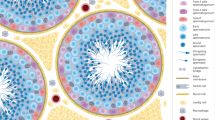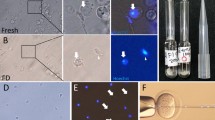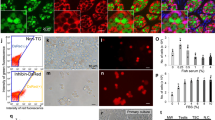Abstract
Spermatozoa from a number of species can be cryopreserved and then subsequently used to fertilize eggs1. However, this technique has several limitations. First, the freezing protocol varies for each species and must be determined empirically, and for some species appropriate methods have not yet been identified1,2. Second, because these cells are fully differentiated, they will not undergo replication when thawed, and recombination of genetic information cannot occur. We now demonstrate, by using the recently developed spermatogonial transplantation technique3,4, that male germline stem cells can be successfully cryopreserved. Donor testis cells isolated from prepubertal or adult mice and frozen from 4 to 156 days at −196 °C were able to generate spermatogenesis in recipient seminiferous tubules. Relatively standard preservation techniques were used, suggesting that male germ cells from other species can also be stored for long periods. Because transplanted testis stem cells will ultimately undergo replication and meiotic recombination during spermatogenesis, one might consider these preserved male germ lines as biologically immortal.
This is a preview of subscription content, access via your institution
Access options
Subscribe to this journal
Receive 12 print issues and online access
$209.00 per year
only $17.42 per issue
Buy this article
- Purchase on Springer Link
- Instant access to full article PDF
Prices may be subject to local taxes which are calculated during checkout
Similar content being viewed by others
References
Hafez, E.S.E. Preservation and cryopreservation of gametes and embryos. in Reproduction in Farm Animals, 6th edn. (ed. Hafez, E.S.E.) 503–525 (Lea & Febiger, Philadelphia, 1993).
Tada, N. et al. Cryopreservation of mouse spermatozoa in the presence of raffi-nose and glycerol. Reprod. Fert. 89, 511–516 (1990).
Brinster, R.L. & Zimmermann, J.W. Spermatogenesis following male germ cell transplantation. Proc. Natl. Acad. Sci. USA 91, 11298–11302 (1994).
Brinster, R.L. & Avarbock, M.R. Germline transmission of donor haplotype following spermatogonial transplantation. Proc. Natl. Acad. Sci. USA 91, 11303–11307 (1994).
Baker, T.G. Oogenesis and ovarian development. in Reproductive Biology (eds. Balin, H. & Glasser, S.) 398–437 (Excerpta Medica, Amsterdam, 1972).
Russell, L.D., Ettlin, R.A., Hikim, A.P. & Clegg, E.D. Mammalian spermatogenesis. in Histological and Histopathological Evaluation of the Testis 1–40 (Cache River Press, Clearwater, Florida, 1990).
Ewing, L.L., Davis, J.C. & Zirkin, B.R. Regulation of testicular function: A spatial and temporal view. in International Review of Physiology (ed. Creep, R.O.) 41–115 (University Park Press, Baltimore, 1980).
De Rooij, D.G., Van Dissel-Emiliani, F.M.F. & Van Pelt, A.M.M. Regulation of spermatogonial proliferation. Annu. NY Acad. Sci. 364, 140–153 (1992).
Gosden, R.G. Transplantation of ovaries and testes. in Fetal Tissue Transplants in Medicine (ed. Edwards, R.G.) 253–280 (Cambridge Univ. Press, New York, 1992).
Deanesly, R.J. Spermatogenesis and endocrine activity in grafts of frozen and thawed rat testis. Endocrinology 11, 201–206 (1954).
Zambrowicz, B.P. et al. Expression of a mouse Zfy-1/lacZ transgene in the somatic cells of the embryonic gonad and germ cells of the adult testis. Development 120, 1549–1559 (1994).
Freshney, R.I. Instability, variation, and preservation. in Culture of Animal Cells, 3rd edn. (ed. Freshney, R.I.) 253–266 (Wiley-Liss, New York, 1994).
Bucci, L.R. & Meistrich, M.L. Effects of busulfan on murine Spermatogenesis: Cytotoxicity, sterility, sperm abnormalities, and dominant lethal mutations. Mutat. Res. 176, 259–268 (1987).
Dym, M. The male reproductive system. in Histology Cell and Tissue Biology, 5th edn. (ed. Weiss, L.) 1000–1053 (Elsevier Science Pub. Co., New York, 1993).
Meistrich, M.L. Nuclear morphogenesis during spermiogenesis. in Molecular Biology of the Male Reproductive System (ed. de Kretser, D.) 67–97 (Academic Press, New York, 1993).
Clermont, Y., Oko, R. & Hermo, L. Cell biology of mammalian spermiogenesis. in Cell and Molecular Biology of the Testis (eds. Desjardins, C. & Ewing, L.L.) 332–376 (Oxford Univ. Press, New York, 1993).
Setchell, B.P. Spermatogenesis and spermatozoa. in Reproduction in Mammals: Germ Cells and Fertilization, 2nd edn. (eds. Austin, C.R. & Short, R.V.) 63–101 (Cambridge Univ. Press, New York, 1982).
Clouthier, D.E., Avarbock, M.R., Maika, S.D., Hammer, R.E. & Brinster, R.L. Rat Spermatogenesis. Nature 381 (in the press).
Kimura, Y. & Yanagimachi, R. Mouse oocytes injected with testicular spermatozoa or round spermatids can develop into normal offspring. Development 121, 2397–2405 (1995).
Aitken, R.J. & Irvine, D.S. Fertilization without sperm. Nature 379, 493–495 (1996).
Fishel, S. et al. Pregnancy after intracytoplasmic injection of spermatid. Lancet 345, 1641–1642 (1995).
Tesarik, J., Mendoza, C. & Testart, J. Viable embryos from injection of round spermatids into oocytes. N. Engl. J. Med. 333, 525 (1995).
Bellvé, A.R. et al. Spermatogenic cells of the prepubertal mouse. Cell Biol. 74, 68–85 (1977).
Bellvé, A.R. Purification, culture, and fractionation of Spermatogenic cells. Methods Enzymol. 225, 84–113 (1993).
Robertson, E.J. Embryo-derived stem cell lines. in Teratocarcinomas and Embryonic Stem Cells: A Practical Approach (ed. Robertson, E.J.) 71–112 (IRL Press, Oxford, 1987).
Author information
Authors and Affiliations
Rights and permissions
About this article
Cite this article
Avarbock, M., Brinster, C. & Brinster, R. Reconstitution of spermatogenesis from frozen spermatogonial stem cells. Nat Med 2, 693–696 (1996). https://doi.org/10.1038/nm0696-693
Received:
Accepted:
Issue Date:
DOI: https://doi.org/10.1038/nm0696-693
This article is cited by
-
Melatonin in cryopreservation media improves transplantation efficiency of frozen–thawed spermatogonial stem cells into testes of azoospermic mice
Stem Cell Research & Therapy (2022)
-
Effect of a Freezing Medium Containing Melatonin on Markers of Pre-meiotic and Post-meiotic Spermatogonial Stem Cells (SSCs) After Transplantation in an Azoospermia Mouse Model Due to Testicular Torsion
Reproductive Sciences (2021)
-
Germ cell depletion in recipient testis has adverse effects on spermatogenesis in orthotopically transplanted testis pieces via retinoic acid insufficiency
Scientific Reports (2020)



